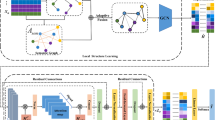Abstract
Multilayer perceptron (MLP) with recurrent architecture is proposed for stabilizing the state vector, which represents the characteristics of the nodes in a graph, to classify the graph structured data. M number of input and output networks are constructed for the M node undirected graphs for classifying graph structured data. Output of every input network represents the characteristics of the node as a state vector. The output of each input MLP is also taken as input for the same network along with output of neighboring node’s MLP. Both the input and output networks are trained by backpropagation. The proposed approach is implemented on the standard benchmark classification problems namely mutagenesis problem, subgraph matching problem and clique problem. Simulation results show that best accuracy in classification is obtained with minimum computational complexity.








Similar content being viewed by others
References
Atiya A (1988) Learning on a general frame work, neural information processing systems. In: Anderson DZ (ed) AIP, New York, pp 22–30
Bianchini M, Maggini M, Sarti L, Scarselli F (2005) Recursive neural networks for processing graphs with labeled edges: theory and applications. Neural Netw 18:1040–1050
Bianchini M, Gori M, Sarti M, Scarselli F (2006) Recursive processing of cyclic graphs. IEEE Trans Neural Netw 17(1):10–17.
Bong DBL, Tan JYB, Lai KC (2008) Application of multilayer perceptron with backpropagation algorithm and regression analysis for long-term forecast of electricity demand—a comparison. Int Conf Electron Des 3:1–5
Chatrand G (2006) Introduction to Graph Theory. Tata Mc Graw-Hill, New Delhi
De Raedt L, Blockeel H (1997) Using logical desicion trees for clustering. Lecture notes in artificial intelligence, vol 1297. pp 133–141
Debnath AK, Lopex de Compandre R, Debnath G, Schusterman A, Hansch C (1991) Structure-activity relationship of mutagenic aromatic and heteroaromatic nitro compounds correlation with molecular orbital energies and hydrophobicity. J Med Chem 34:786–797
Elman J (1990) Finding structure in time. Cogn Sci 14:179–211
Frasconi P, Gori M, Sperduti A (1998) A general framework for adaptive processing of data structures. IEEE Trans Neural Netw 9:768–786
Frasconi P, Gori M, Sperduti A (1997) On the efficient classification of data structures by neural networks. In: Proceedings of Fifteenth International Joint Conference Artificial Neural Networks, vol 2. pp 1066–1071
Jain SK, Patnaik A, Sinha SN (2013) Design of custom made stacked patch antennas: a machine learning algorithm. Int J Mach Learn Cybern 4:189–194
Khotanzad A, Chung C (1998) Application of multilayer perceptron neural networks to vision problems. Neural Comput Appl 7:249–159
Kirsten M (2002) Multirelational distance-based clustering. Ph.D dissertation, School of computer Science, Otto-von-Guericke University, Magdeburg, Germany
Noi LD, Hagenbuchner M, Scarselli F, Tsoi AC (2010) Web spam detection by probability mapping graph self organising maps and graph neural networks, Artificial Neural Networks, ICANN 2010. Lecture notes in computer science, vol 6353. pp 372–381
Pollack JB (1990) Recursive distributed representations. Artifi Intell 46:77–106
Pucci A, Gori M, Hagenbuchner M, Scarselli F, Tsoi AC (2006) Applications of graph neural networks to large-scale recommender systems some results. In: Proceedings of International Multiconference on Computer Science and Information Technology, pp 189–195
Rumelhart DE, Hinton GE, Williams RJ (1986) Learning reprsentations by back-propagation errors. Nature 323:533–536
Savitha R, Suresh S, Sundarajan N (2013) Fast learning complex valued classifiers for real world classification problems. Int J Mach Learn Cybern 4:469–476
Sperduti A (1998) Neural networks for processing data structures, Adaptive processing of sequences and data structures. Lecture Notes in Computer Science, vol 1387. pp 121–144
Sperduti A, Starita A, Goller C (1995) Learning distributed representations for the classification of terms. In: Proceedings of International Joint Conference on Artificial Intelligence, pp 509–515
Sperduti A, Starita T (1997) Supervised neural networks for classification of structures. IEEE Trans Neural Netw 8:714–735
Scarselli F, Gori M, Tsoi AC, Hagenbuchner M, Monfardini G (2009) The graph neural network model. IEEE Trans Neural Netw 20:61–80
Scarselli F, Gori M, Tsoi AC, Hagenbuchner M, Monfardini G (2009) Computational capabilities of graph neural networks. IEEE Trans Neural Netw 20:81–102
Scarselli F, Yong SL, Gori M, Hagenbuchner M, Tsoi AC, Maggini M.(2005) Graph neural networks for ranking web pages. In: Proceedings of the 2005 IEEE/WIC/ACM Conference on Web Intelligence, Washington DC, pp 666–672
Srinivasan A, Muggleton S, King R, Sterbberg M (1994) Mutagenesis: Ilp experiments in a non-determinate biological domain. In: Proceedings of 4th International Workshop Inductive logic Programme, pp 217–232
Tsang E, Wang X, Yeung D (2000) Improving learning accuracy of fuzzy decision trees by hybrid neural networks. IEEE Trans Fuzzy Syst 8:601–614
Wang X, Dong C, Fan T (2007) Training T-S norm neural networks to refine weights for fuzzy if-then rules. Neurocomputing 70:2581–2587
Author information
Authors and Affiliations
Corresponding author
Rights and permissions
About this article
Cite this article
Gnana Jothi, R.B., Meena Rani, S.M. Hybrid neural network for classification of graph structured data. Int. J. Mach. Learn. & Cyber. 6, 465–474 (2015). https://doi.org/10.1007/s13042-014-0230-8
Received:
Accepted:
Published:
Issue Date:
DOI: https://doi.org/10.1007/s13042-014-0230-8




